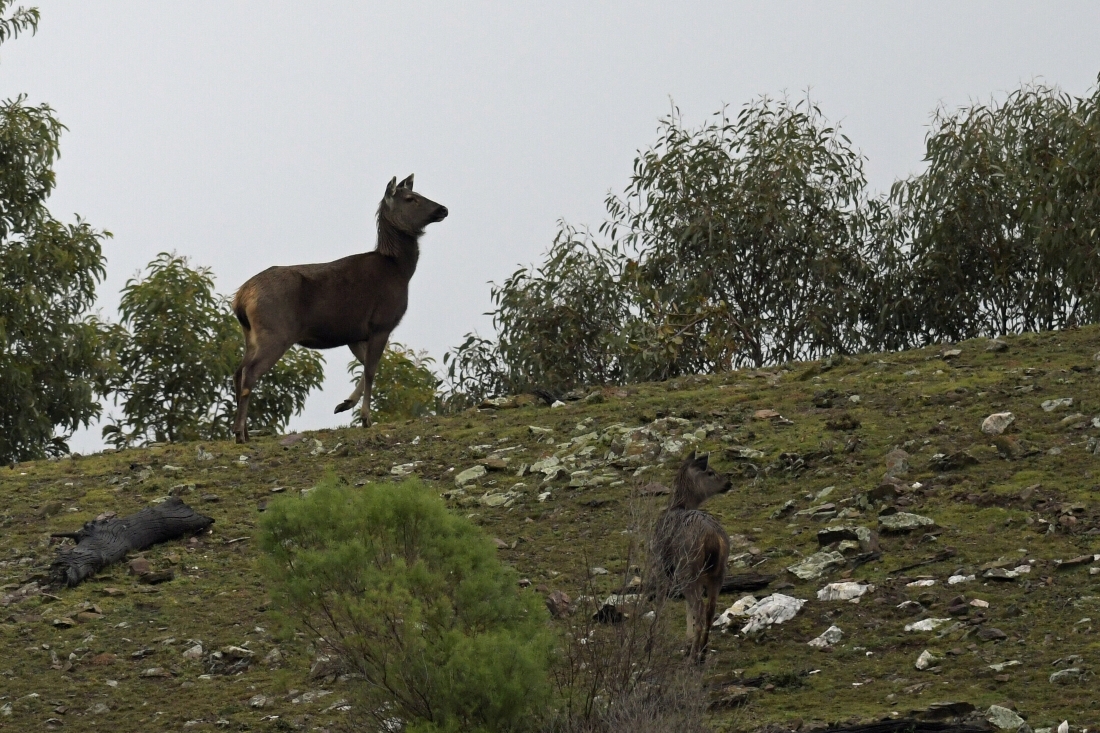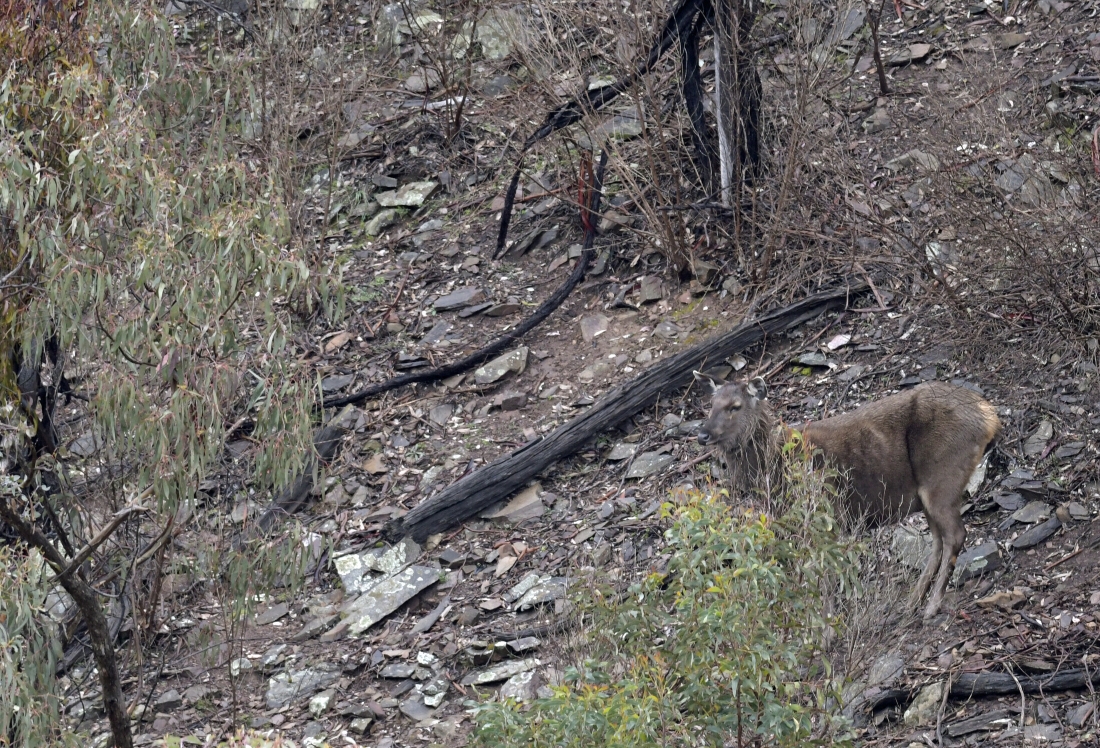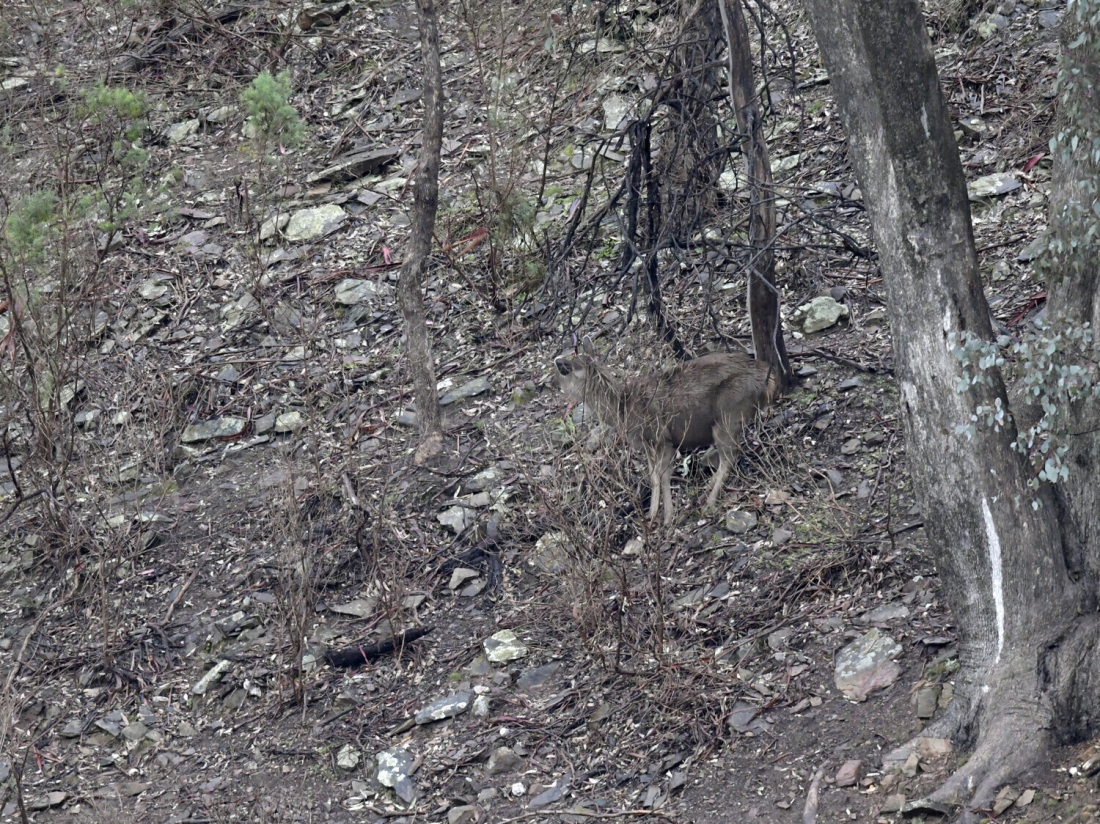Errol Mason's Hunt Smart ® Training Course Sambar Observation
Photo Details Training Course 31st July to 1st August 2021
Friday 30st July. Constant gusting wind was preceding a cold front. Temperature at first light was mild but the wind chill was uncomfortable.
Saturday 31th July. Temperature first light 6.9C. A gusting wind blew all day.
After the morning scenario training, at 2pm we moved to another location where we found 2 mature hinds – one of which was heavily pregnant. They were in a gully head right on the Wagon Wheel Rim and in the lee of gusting wind that had been battering the area all Friday and Saturday. The first to be seen had been bedded until I blew on the Fox 40 Sonik Blast whistle. A participant spotted her the instant she stood in her bed and stared towards us. We observed them for 20 minutes or so during which the first hind never moved from her bed and the pregnant one grazed slowly along the Wagon Wheel Rim. They were in the same spot on the Wagon Wheel Rim where I have seen up to six on previous courses when this spot provided them with comfort and security that they required in the prevailing conditions. No photos taken of this observation. We then moved to the next scenario.
On Saturday night it rained steadily for much of the night.
Sunday 1st August. First light 6.45am. Temperature first light 6.8C. After raining much of the night, the rain cleared about 30 minutes after first light to a bleak overcast morning.
I applied all the relevant overlays to determine where the sambar would be shortly after first light. We then moved quickly along a low impact route to a vantage point overlooking that spot. Due to the forest being sodden by overnight rain and the heavily overcast sky, the level of light was very low. Within a minute I spotted a mature hind and a minute or so later a participant spotted a juvenile 20 metres behind her. Participants were glued to them because for most this was the very first time they had seen unalarmed sambar.
Soaked by overnight rain the very wet hind was warming up whilst drying out in whatever solar energy was penetrating the dark cloud cover. Participants noted how she was constantly alert, ears swivelling this way and that, nostrils inhaling air, testing for predatory scent, and head turning in various directions. They were amazed at how she stood in the same place for almost one hour without moving anything except her head, ears and nostrils. Several reacted with "now I understand why I always spook them well before I see them and by then it's too late - I'm lucky if I get a glimpse."
I explained everything participants needed to know about taking a shot at a standing or bedded sambar in this situation. Then, using my Remington 700 CDL 30-06 and Vixen 2.5-10x56 scope supported by bipod shooting sticks, each took a simulated 280 yard shot at her. Each said they were so steady they could have hit precisely where they had aimed. Nevertheless, I explained that in human terms, shooting one in a favourite gully was the equivalent to doing a home invasion which would cause a mother to move her family to a safer place.
I explained that it’s preferable to harvest a deer as it moves between the restaurant (feeding ground) and the home (bedding area) or vice versa, for in human terms that’s the equivalent to having your car high-jacked on a street, which would not cause a mother to move her family out of their home. We then examined the preferred ambushing spot I was referring to, the low impact route I would use to get to it and precisely where and how I would set up.
Later I explained why these deer were in this spot and the overlays I applied to find them; why they were standing rather than lying; why they were broadside to us and why they were motionless whilst the matriarch checked constantly for danger.
After they moved slowly behind cover, to try and attract them back into view I blew a predator call which imitated a squealing calf or rabbit, but it had the opposite effect. Within seconds the matriarch decided it was time to get out of there - and fast. With hindsight that made perfect sense. Squealing similar to a sambar calf suggested a predator was near so she lost no time extracting her vulnerable juvenile from that gully, rather than approaching the location of a potential predator. Had she had a young calf hidden close to my position she may well have charged towards me, which is precisely what happened one morning when my English Pointer stalked within a metre of a week old calf, causing it to emit an incredibly loud squeal.
As the hind moved away I anticipated her escape route and fixed my super telephoto lens on an opening on the very steep face I expected her to ascend. Within a minute or so she entered that clearing at a fast walk, moving diagonally towards a large eucalypt before disappearing behind its canopy.
Within seconds she reappeared as she strode up the steep face between the canopy and the spur line. The moment she reached the spurline 500 yards from us, I gave one loud blast on my Fox 40 Sonik Blast whistle. Because she was already badly spooked by the predator call, she stopped broadside for just five or so seconds - just enough time for me to snap a few photos - before disappearing over the top. If she had not been alarmed by the call prior to hearing the whistle she would have stopped and stared towards the whistle easily long enough for a well-aimed broadside shot. Nevertheless - another enthralling Hunt Smart "Red Letter" Day was enjoyed by all.
We then analysed our observations of the previous hour or so. I explained to the participants all the overlays I had applied to determine where the deer would be at that time of the morning. I had taken into account that it had rained throughout the night, but had cleared soon after first light. These overlays took into account their hierarchy of needs - or to put it another way - where the deer would be the most comfortable and secure in the prevailing conditions. I explained why I had chosen to take them to that vantage point to look for deer, rather than to another which would have given us precisely the opposite view to where the deer were highly unlikely to be in the conditions.

Despite being spooked by the predator call, one blast from my Fox 40 Sonik Blast whistle momentarily stopped her and her offspring in their tracks.

Her soaked back shines as this hind quickly ascends this very steep face with her juvenile in tow.

Soaked from the overnight rain this very wet Hind warms up whilst drying out in whatever solar energy is able to penetrate the heavy cloud cover. Participants noted how she was constantly alert, ears swivelling this way and that, nostrils testing the air for scent and head turning in various directions. They were amazed at how she stood in the same place for almost one hour without moving anything but her head and ears. Several reacted with "now I understand why I always spook them well before I see them and by then it's too late - I'm lucky if I get a glimpse."

The Hinds' very wet and cold juvenile warms up whilst drying out in whatever solar energy is able to penetrate the heavy cloud cover. Younger, smaller sambar are stressed much more by cold than much larger mature specimens.
